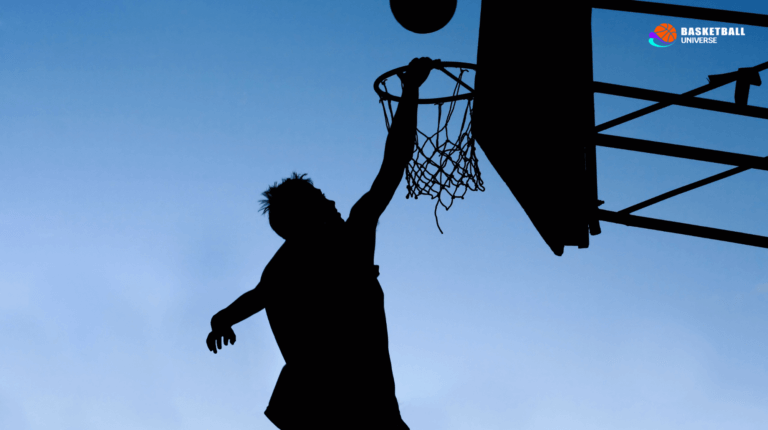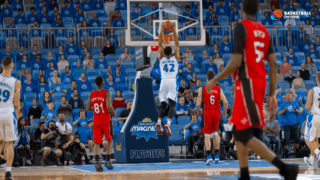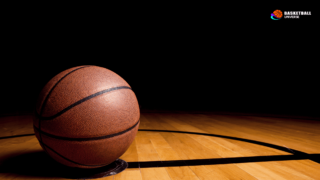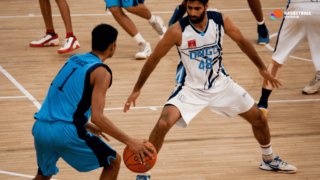
When it comes to athletic footwear, are basketball and volleyball shoes interchangeable? If you’ve ever found yourself pondering this tantalizing question, you’re in luck! Our deep dive into this athletic conundrum will help set the record straight and even tickle your curiosity. With performance, style, and comfort all vying for the spotlight, we’re here to explore the key differences and draw a clear line between these two pairs of sporty kicks. So, lace up and get ready for a lively and informative journey into the realm of basketball and volleyball shoes!
Are Volleyball and Basketball Shoes the Same?
While basketball and volleyball shoes may share some similarities, they are not the same. Basketball shoes are often heavier, with features designed to provide extra ankle support and cushioning for jumps and hard landings. Volleyball shoes, on the other hand, are typically lighter and focus on stability and grip to accommodate the quick lateral movements and jumps required in the sport. Players should choose the appropriate footwear for each sport to maximize performance and prevent injuries.
Unraveling the Shoe Mystery: Basketball vs Volleyball
In a world where athletic shoes dominate the footwear industry, understanding the subtle differences between a volleyball shoe and a basketball shoe can make all the difference in optimizing your on-court performance. We’re here to lay it all out for you, so you’re armed with the knowledge needed to make the best choice for your athletic endeavors. Let’s begin with a focus on the differences in design and construction of both shoes.
Design and Construction: More than Meets the Eye
When examining volleyball and basketball shoes, there are a few key differences in design and construction that set them apart. This section will highlight the design elements that make each shoe unique.
Ankle Support: Guarding the Achilles Heel
Playing basketball often requires more aggressive and powerful movements, such as sudden changes in direction, explosive jumps, and hard landings. Basketball shoes are designed with higher collars to provide extra ankle support that’ll help prevent injuries related to twisting or rolling your ankle. Volleyball shoes, on the other hand, tend to have lower or medium collar heights since ankle stability in volleyball is focused more on lateral support and swift movements.
Midsole: Cushioning the Impact
Both volleyball and basketball shoes require cushioning due to the frequency of jumps and landings on hard courts. However, basketball shoes generally feature thicker and more robust midsoles to handle the weight and impact of powerful leaps and landings, thus providing better shock absorption. Volleyball shoes typically have thin-to-medium midsoles to balance cushioning and a low profile for agility and swift changes in direction.
Outsole: Gripping the Court
A shoe’s outsole plays an essential role in providing traction on the court, as athletes rely on a solid grip to avoid slipping and make fast moves. While both volleyball and basketball shoes have non-marking rubber outsoles to avoid leaving marks on the court, there’s a variation in their traction patterns. For instance, basketball shoes tend to have a herringbone pattern, which offers excellent multidirectional grip, while volleyball shoes generally either have a web-like or spiral structure, which offers better lateral grip and even court contact.
Comparing the Top Brands: A Side-by-Side Showdown
Now that we have a better understanding of how basketball and volleyball shoes are constructed, let’s take a look at some of the top brands and models in each category to see how these differences manifest in the real world.
ASICS GEL-Rocket vs Nike Hyperdunk
As one of the most popular volleyball shoes on the market, the ASICS GEL-Rocket provides a great case study. Boasting a low-profile design and gel cushioning in the forefoot, the GEL-Rocket caters to volleyball athletes looking for responsiveness and lateral support. Compare this to Nike’s Hyperdunk – a renowned basketball shoe known for its high collar, plush cushioning, and sturdy construction – and it becomes clear that the differences in design are more than skin deep.
Mizuno Wave Lightning vs Adidas Harden
Mizuno’s Wave Lightning is another top pick in the volleyball shoe category. With its lightweight construction and parallel wave technology, this shoe offers exceptional stability and shock absorption for the volleyball court. On the other side, we have the Adidas Harden, a popular basketball shoe lineup. These shoes offer a comfortable yet supportive fit, with chunky Boost cushioning to help absorb high-impact landings. The design approaches of these two shoes further illustrate the dissimilarities between what each shoe is built to achieve.
Fitting Matters: A Size Just Right
Proper fit is critical when selecting athletic shoes, as a well-fitted shoe can improve your performance and prevent injuries. When it comes to the basketball-volleyball shoe debate, the sizing, fitting, and comfort factors between the two may vary, so we’re here to guide you on finding the right fit for your needs.
Basketball Shoes: Snug and Secure
Basketball shoes are designed to have a tight and snug fit, especially around the midfoot, to provide stability and prevent the foot from rolling inside the shoe during those clutch moments. Therefore, choosing the right size that offers a secure fit without sacrificing comfort is essential in basketball shoes.
Volleyball Shoes: Freedom to Fly
With a focus on swift movements, agility, and quick jumps, volleyball shoes require a lightweight, comfortable, and breathable fit. A well-fitting volleyball shoe should provide a snug fit in the heel, offer support in the midfoot, and have sufficient room for your toes to avoid discomfort while still ensuring agility and court grip. Picking the right size for volleyball shoes can make all the difference on the court.
Price Points: Weigh-In on Your Wallet
As with any athletic gear, price is a crucial factor when choosing between basketball and volleyball shoes. Although some models may overlap in price, generally, there’s a notable difference between both types of shoes in terms of their target markets and typical costs.
Basketball Shoes: Style and Substance
Basketball shoes combine performance with fashion appeal, resulting in a wide price range that depends on factors such as endorsements, brand prestige, design quality, and technological innovation. With an incredible variety of styles, colorways, and price tags – ranging anywhere from $50 to over $200 – there’s truly a basketball shoe available for every budget and style preference.
Volleyball Shoes: Focused and Functional
Volleyball shoes tend to be more focused on functionality and performance than on fashion statements or brand recognition. Although they share some technologies and innovative design elements with basketball shoes, volleyball shoes are typically more affordable, with price tags mostly ranging between $40 and $150. This price range makes volleyball shoes a more accessible option for athletes concentrating on performance.
Breaking it Down: Basketball and Volleyball Shoe Comparison
By now, it’s clear that basketball and volleyball shoes serve different purposes and are designed to meet the specific needs of their respective sports. To provide a quick snapshot of their differences, we’ve broken down the key contrasts into a handy comparison table below:
| Feature | Basketball Shoes | Volleyball Shoes |
|---|---|---|
| Ankle Support | Higher collar for increased ankle protection | Lower or medium collar, focused on lateral support |
| Midsole Cushioning | Thicker midsole for better shock absorption | Thin-to-medium midsole for a balance of cushioning and agility |
| Outsole Traction | Herringbone pattern for multidirectional grip | Web-like or spiral pattern for lateral grip and even court contact |
| Price Range | $50 to over $200 (wide range due to endorsements, brand prestige, and design) | $40 to $150 (generally more affordable) |
As you can see, although basketball and volleyball shoes share some similar features, they serve distinct purposes and should be treated as such. The next time you hit the (volley)ball or basketball court, remember to don your proper athletic footwear to ensure optimal performance, safety, and fun!
Cross-Training: Mixing and Matching Between Volleyball and Basketball
While we’ve established that volleyball and basketball shoes are not the same, you may still be wondering whether it’s acceptable to wear one type of shoe for the other sport in a pinch. The truth is, while it’s not ideal to mix-match, doing so for a casual game or occasional practice session may not harm your performance or cause severe injuries. However, if you’re involved in competitive play or frequent training, it’s crucial to invest in the appropriate footwear.
The Risks of Using Basketball Shoes for Volleyball
Using basketball shoes for volleyball might feel cumbersome due to the higher collars, which may hinder your freedom of movement on the court. Basketball shoes also tend to be heavier, and their outsole traction patterns differ, which could put you at a disadvantage when it comes to quick lateral movements crucial in volleyball games.
The Risks of Using Volleyball Shoes for Basketball
Wearing volleyball shoes for basketball could be risky due to the absence of proper ankle support needed for the explosive movements and hard landings associated with basketball. Also, the thinner midsoles found in volleyball shoes may not provide enough cushioning, leading to discomfort and long-term risks of injury or joint stress when playing basketball.
Caring for Your Volleyball and Basketball Shoes
Regardless of whether you own basketball or volleyball shoes, taking the proper care of your athletic footwear can go a long way in prolonging their lifespan and preserving their performance. Let’s look at a few shoe care tips that’ll help you get the most out of your volleyball or basketball shoes:
Clean Your Shoes Regularly
Keep your shoes free from dust, dirt, and sweat by cleaning them regularly using a gentle brush or cloth. If necessary, use a mild detergent, but make sure not to soak the material, especially if the shoe features leather or suede components. Always air dry your shoes after cleaning; avoid exposing them to direct sunlight or heat sources, as this could damage the structure.
Alternate Between Pairs
If you train or play often, consider investing in a second pair of shoes and alternate between them for each session. It allows the cushioning and materials to bounce back and last longer, resulting in better support and comfort during play.
Don’t Use Shoes Off-Court
To maintain your shoes’ performance, reserve your volleyball or basketball shoes solely for their intended purpose – playing on the court. Using them off-court or wearing them on rough surfaces could damage their outsole and degrade their traction, affecting their on-court performance.
Final Thoughts: Making the Right Choice
While volleyball and basketball shoes may appear similar at first glance, their differences in design, support, cushioning, and traction make them distinct from one another. Therefore, it’s essential to choose the appropriate footwear when engaging in volleyball or basketball activities. Not only can the right shoes enhance your performance, but they also contribute to the prevention of injuries, ensuring that you can continue enjoying your favorite sport for years to come.
Frequently Asked Questions (FAQs)
Before you hit the court, it’s important to have a solid understanding of the differences between volleyball and basketball shoes. Below are 13 frequently asked questions to help answer your concerns and further inform your decision-making process.
1. Can I play volleyball in basketball shoes?
While it’s not ideal, you may play volleyball in basketball shoes for a casual game or occasional practice session. However, for competitive play or frequent training, it’s best to invest in volleyball-specific shoes to optimize performance and prevent injuries.
2. Can I play basketball in volleyball shoes?
Using volleyball shoes for basketball is risky due to the lack of proper ankle support and sufficient cushioning for the sport. While you may wear them for a casual, one-off game, it’s crucial to use appropriate basketball shoes for competitions or regular practice.
3. Which type of shoe offers better ankle support?
Basketball shoes offer better ankle support, as they are designed with higher collars to prevent injuries related to twisting or rolling your ankle during aggressive and powerful movements.
4. Are basketball and volleyball outsoles the same?
No. Basketball shoes typically have a herringbone pattern for multidirectional grip, while volleyball shoes generally feature a web-like or spiral pattern for better lateral grip and even court contact.
5. Is cushioning the same for both types of shoes?
While both types require cushioning for jumps and landings, basketball shoes have thicker and more robust midsoles for better shock absorption. Volleyball shoes usually have thin-to-medium midsoles to balance cushioning and agility.
6. Are volleyball shoes lighter than basketball shoes?
Yes, volleyball shoes are typically lighter than basketball shoes. This allows for greater agility and swift movements on the volleyball court.
7. Can you use indoor soccer shoes for volleyball?
Although indoor soccer shoes may offer a similar low profile to volleyball shoes, they lack specific features tailored to the demands of volleyball, like proper lateral grip. It’s better to invest in volleyball-specific shoes for optimal performance.
8. Is it essential to have specific shoes for volleyball?
Having volleyball-specific shoes can greatly benefit your performance, safety, and comfort during games and practices. The right footwear is designed to meet the demands of the sport, such as supporting swift lateral movement and providing the necessary court grip.
9. How long do volleyball shoes last?
The lifespan of volleyball shoes can vary depending on factors like frequency of use, quality, and care. Generally, replacing them every six months to a year is recommended for regular players. Monitor signs of wear and tear to determine when it’s time for a new pair.
10. Can I use outdoor basketball shoes for indoor volleyball?
While outdoor basketball shoes may be more durable and offer some grip, the outsole pattern and level of ankle support might not be ideal for indoor volleyball. It’s recommended to invest in volleyball-specific shoes for optimal performance.
11. How do I choose the best volleyball shoes?
Consider factors like your position on the court, foot shape, and personal preferences when choosing volleyball shoes. Look for a lightweight, supportive, and comfortable fit with adequate grip and stability features. Trying on different styles and brands can help you find the perfect shoes for your needs.
12. How do I know when it’s time to replace my volleyball shoes?
Monitor signs of wear and tear, such as worn-out outsoles or decreased cushioning. If your shoes start compromising your performance, safety, or comfort, it’s a good indicator that it’s time to replace them.
13. Why are volleyball shoes more affordable than basketball shoes?
Volleyball shoes tend to prioritize functionality over fashion statements or brand recognition. While they still share some innovative design elements and technologies with basketball shoes, they are typically more affordable and accessible to players focusing on performance.
Featured Posts
- No pillar pages found.





